
Skyway in situ, before the U of MN bought it for $1, and City Desk Studio bought it for $5,000
City Desk Studio is still selling the epic skyway they rescued in 2006. They originally planned to adapt it into a timeshared Skyway Retreat lakefront cabin for $1.2 million. Then when the economy imploded they offered it for sale for just $79,500. A year later they dropped the price to $49,500.
And now they’re willing to pay $5,000 to whoever removes it from the vacant lot near the UofM where it’s been parked for nearly a decade. There’s an RFP, and if no qualified bidder steps forward by the end of the month, the skyway is slated to be demolished.
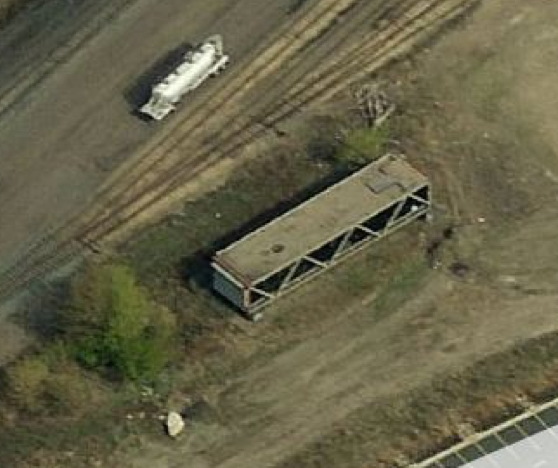
bird’s eye view via bing
The skyway, designed by Ed Banks, the “father of the skyways,” is W20 x L83 x H14 ft and made of steel, glass and concrete. It weighs 280,000 pounds, roughly half of which had been attributed to the 12-inch concrete floor. But using the standard for reinforced concrete of 150 lb/cu ft, I get a weight for an 18×80 ft floor of 218,000, more than 75%. Maybe the floor’s not an actual foot thick. Or maybe it’s smaller than I’ve estimated. Either way, a significant weight reduction can be achieved by removing the concrete floor before transport.
Which is significant. Because City Desk Studio says it cost them more than their $5,000 purchase price to move the skyway two blocks from UMN to the vacant lot near the railyard where it still sits. But that means it had moved nearly four miles, and across the river, from Nicollet Mall & S 5th St to somewhere near the university stadium site. So put it on a barge and float it down the Mississippi.

load_skyway_onto_barge_here.jpg based on google maps’ hunchback brother google earth
The train right of way goes west and gets very close to the river near a commercial/industrial waterfront site under the 10th Ave Bridge. That’s where you bring your barge and load it on. BAM. Your skyway is now connected to the entire world. You have two weeks to work out the details for removing it, and plenty of time after that to figure out where to take it.
I say you because I have been forbidden from pursuing this perfect plan. But it must happen, and soon. If you use my detailed schematic in your successful rfp, I expect an invitation to your skywaywarming.
Salvaged Minneapolis skyway could be your next home [startribune]
Previously:
2009: Minnesota NICE: Skyway For Sale On Craigslist
2010: That Minnesota Skyway For Sale Again/Still
Tag: shipping containers
Variations On A Charlotte Perriand Beach House
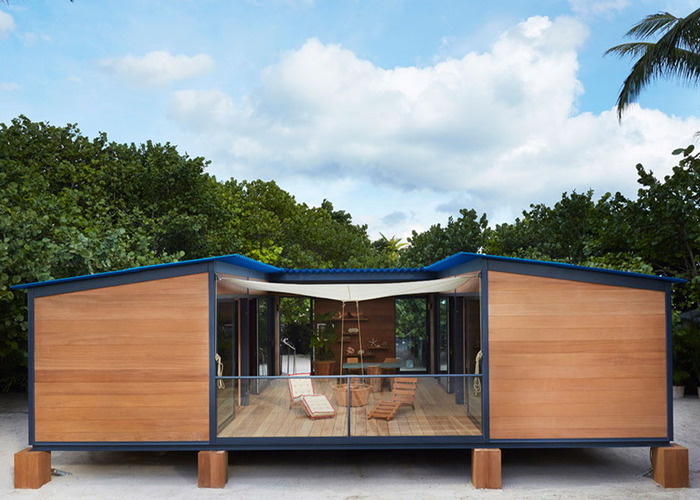
I’m as stoked as I am nonplussed at Louis Vuitton’s over-luxed realization of Charlotte Perriand’s une petite maison au bord de l’eau (1934), which was unveiled at the Raleigh Hotel during Design Miami last month. It’s a small U-shaped shed with glass opening around a canvas-shaded deck.
As LV’s publicists explain it in designboom [small caps sic]:
the pavilion was originally conceived by perriand for an architecture competition sponsored by l’architecture d’aujourd’hui magazine – for which it won second place. she brilliantly prefigures the ease of construction and assembly, and affordability. the pavilion was built (and furnished) by louis vuitton’s inhouse architectural team in collaboration with perriand’s estate to adapt her loose sketches. the design probably would have slipped unnoticed into 20th-century architectural history where it not for julie de libran, the woman’s creative director at louis vuitton.
Mhmm. Except that Perriand’s project is mentioned and reproduced in numerous catalogues and exhibitions of the architect/designer’s work both before her death in 1999, and especially after.
And as for rescuing and realizing Perriand’s history and design, the Perriand archive hasn’t released more than a sketch, and no information about the competition, which was specifically for a weekend beach house, and no information about the variations of the design Perriand made over the years.
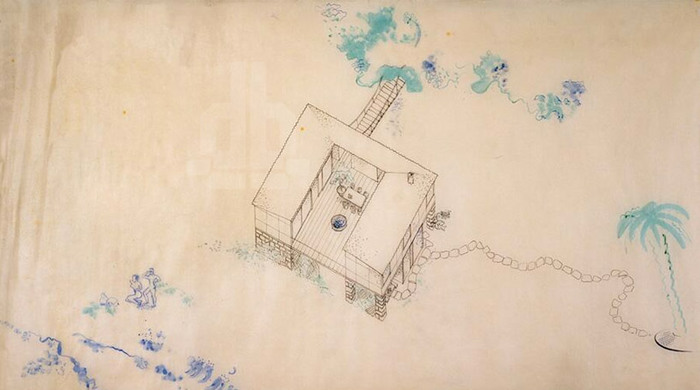
And in realizing the house, Vuitton doesn’t say that they changed it significantly: Perriand’s original concept was for a living space raised on stone columns and walls, with open space underneath for storage and parking. So in structure, material, and affordability, Vuitton’s sleek, hardwood construction is beautiful, but it is not an accurate representation of Perriand’s concept. When a luxury giant like LVMH comes calling, though, the estate [run by Perriand’s daughter] can be flexible. And when design shoppers hit Miami Beach, the right logo can obviate any concern about notions of history, accuracy, or context. The Perriand pavilion [sic] was for sale; it’s not clear if it sold.
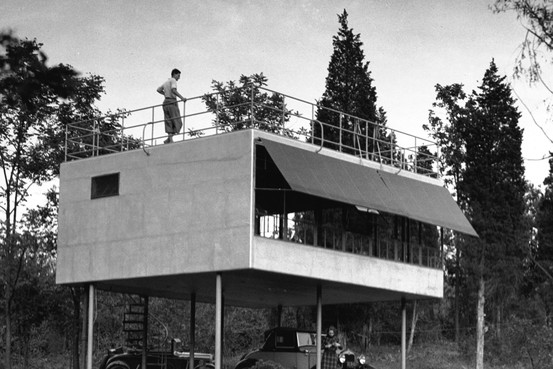
But the entire project demands an open reinterpretation that tries to be true to Perriand’s original design–or at least to the aspects of it that don’t appeal to a fashion marketing priorities of a luxury purse manufacturer. Imagine an ultralight version built on pilotis, and realized in, say, sealed canvas, like the beach cottage Albert Frey & Lawrence Kocher built in Northport, LI in 1933-4?
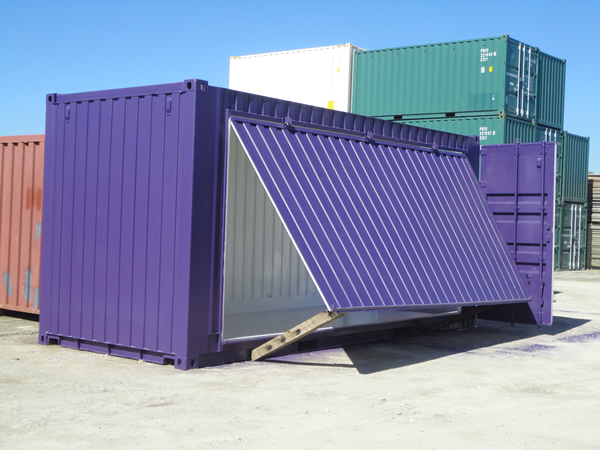
image: abc containers (au)
Or bring it all forward. Who can look at the Vuitton Perriand House and not think of shipping containers? Two 40’s open on the side, and a 20′ in the middle, BAM.
charlotte perriand’s la maison au bord de l’eau is a louis vuitton tribute [designboom]
Louis Vuitton realises unbuilt Charlotte Perriand beach house in Miami [dezeen]
G8 Pop-Up Prison

Here I am thinking that 12 years into this blogging thing, there’s really no reason to keep shipping containers as their own category anymore, when BAM, up pops a sweet, containerized pop-up prison for G8 protestors in Ireland.
You may remember, or maybe you don’t, that in 2002 Camp Delta, the prison annex to Camp X-Ray at Guantanamo, was quickly built from shipping containers to handle the influx of prisoners from the GWOT.
If there’s a difference between the GTMO container cells and the Irish ones, it’s that the G8 cells are reportedly highly temporary, and that the police are promising that protestors will be arrested, processed, charged, and properly incarcerated in record time, just “a matter of hours.” Europe. It really is the little differences.
G8: Courts ‘can deal with 260 protest arrests a day’ [bbc]
Shipping Container Expressionism
Ian Volner’s spec-heavy article in Architecture Magazine gives a nice hook to finally post about Lo-Tek’s shipping container project, the Whitney Studio.
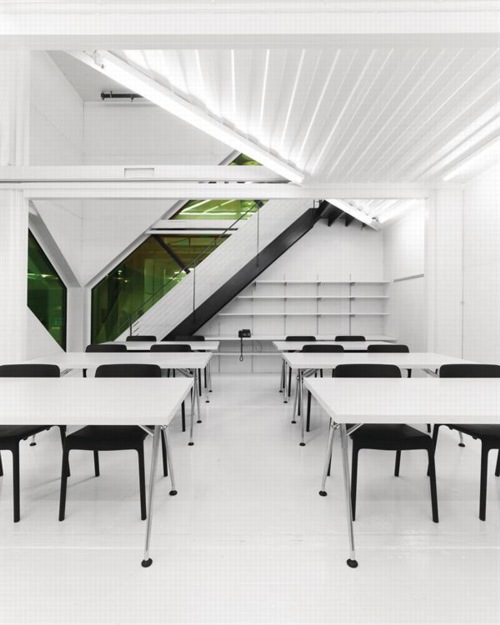
image: Ian Allen, no relation, via archmag
As pioneers in the medium, Ada and Giuseppe know how awful shipping containers can be as built spaces, and they are very skilled at countering the geometric claustrophobia. The diagonal slices of the window and mezzanine are somehow unexpected and obvious, and they really work nicely shoehorned all into and against Breuer’s building.
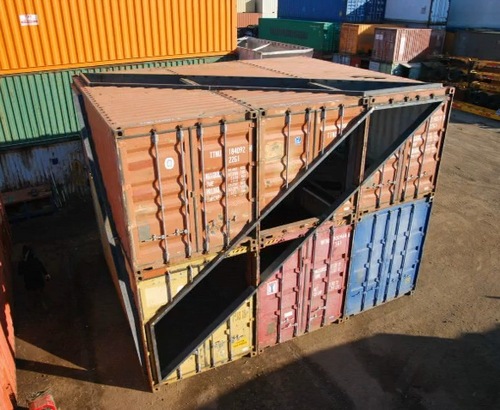
Which is kind of a bummer, because, where’s it going to go when the Whitney decamps for the meatpacking district? As an object, it has its own validity, but it really does get a lot from its crazy site, and that tension will be lost when it is plopped down on some trustee’s rolling lawn.
And don’t look at me to buy it: the Whitney Studio’s just one more in a series of post-museum modular houses I am not collecting. Besides, I think stacking the bedroom containers on top of the Whitney Studio would ruin its cube-y goodness.
Afghanprogettazione: HESCO X DIY Troop Furniture
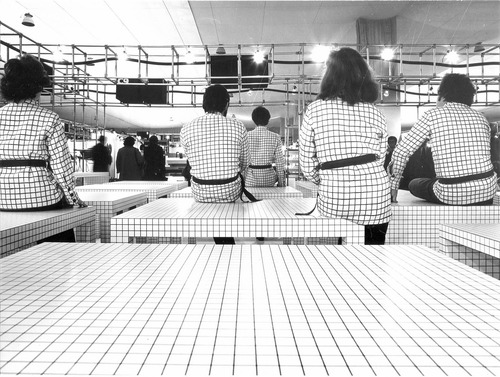
Maybe it’s because I was reading about Jean-Pierre Reynaud and Superstudio’s Quaderna furniture last night, but for the first time, I suddenly noticed the incredible, grid-like mesh gabion fortification and construction system that defines the forward operating bases in Afghanistan: HESCO.

The HESCO Bastion Concertainer, obviously just called Hesco, is a galvanized steel mesh cage lined with non-woven polypropylene geotextile, which can be deployed with local fill ten time more quickly than sandbags, and with 90% less manpower.

It’s light enough to deploy by hand. It folds flat for easy transport. A shipping containerized system called RAID [Rapid In-Theatre Deployment] can be rolled out 1000 feet at a time from the back of a moving truck.
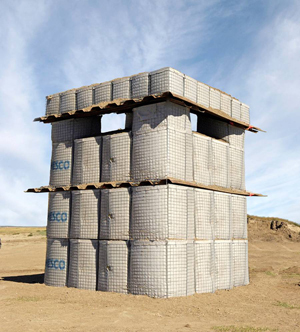
It protects against bullets, car bombs, and artillery fire, and it’s structural, so you can build with it. It’s water- and erosion-resistant, so you can do flood control with it. It’s ubiquitous in Afghanistan to the point of invisibility.
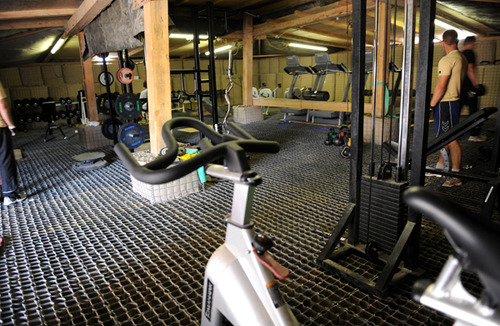
Which is where it starts getting really interesting. Here is a gym, constructed with Hesco pilings and a flattened out Hesco floor, built at a Hesco’d-out Australian forward gunnery base in Helmand last February.

When Hesco meets the ingenuity that produces awesome, homebrewed field furniture knocked together from shipping pallets [above, below]
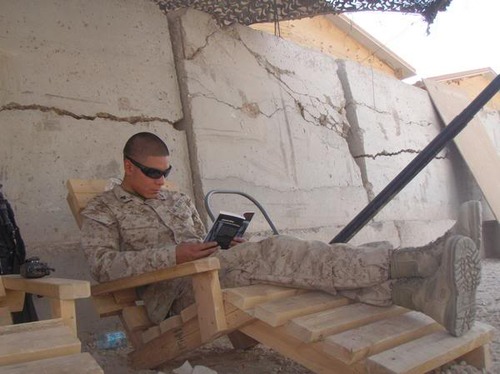
You end up with an entire Hesco living room set, including sofas, a TV stand and side table,
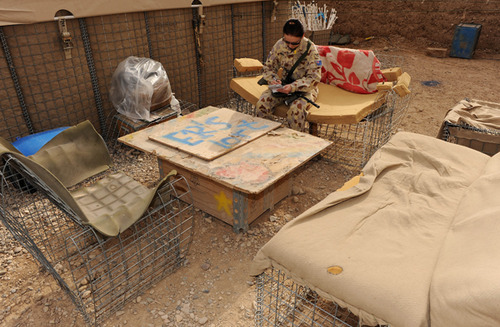
and club chairs and even a garbage can–all apparently noteworthy enough for a visiting commander to photograph and explain in 2010.

It’s like the Amerafghan love child of Staff Sergeant Frank Gehry. Admit it, wouldn’t you have paid more attention to the war if you’d known the troops were hacking such awesome design all this time? Please send more pics!
HESCO Bastions [hesco.com]
Field Furniture, from the Iraq & Afhanistan theaters [pallet images via militaryphotos.net]
12 February 2010 | Commander Joint Task Force visits Aussie gunners in Helmand Province Afghanistan [defence.gov.au]
That Minnesota Skyway For Sale Again/Still
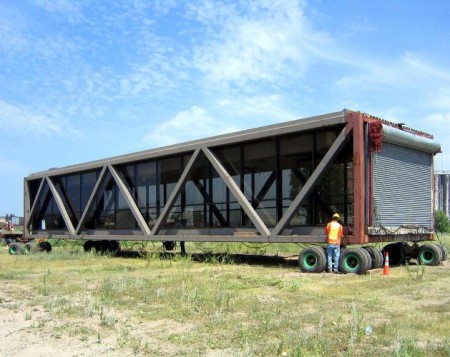
In this difficult real estate environment, close followers of the used modernist Skyway market will note have reason to be optimistic. Even as asking prices have dropped nearly 40% in the last year,–from $79,500,to around $49,500–they are still way above 2002 and 2006 results of $1 and “a very small amount” that’s probably closer to $1 than $49,500, respectively.
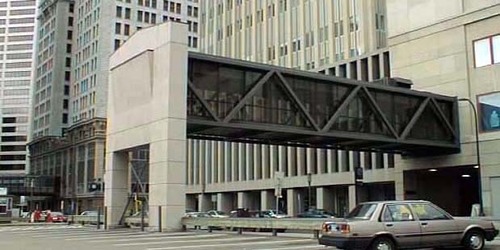
SKYWAY FOR SALE – AGAIN!!! [minneapolis.craigslist.org, thanks sheree from aol]
City Desk Studio architects for all your used Skyway needs [citydeskstudio.com]
Ensure Is George W. Bush’s Blue Gap Dress
Like everyone else in the country, I was glued to the screen September 11th, 1998, scrambling to download the massive Independent Counsel’s Report, aka the Kenneth Starr Report, from a still-scrawny Internet. I finally printed my copy in time for dinner, and my colleague from work and I pored over it at a sidewalk cafe near Dupont Circle, where we had traveled for a client meeting.
At the time, we were advising a group of entertainment and mall development companies on the creation of a startup, the purpose of which was to create the definitive platform for celebrity-driven retail. In other words, monetizable, industrial-scale product placement.
Which is why, while reading parts of the Starr Report out loud to each other, I had one of the lesser epiphanies of my life. I exclaimed to my colleague that this, the Kenneth Starr Report, was proof of the concept. After all, what brand was on every American’s mind that night? Exactly, Gap. the maker of Monica Lewinsky’s blue dress. I resolved right then to register the domain kennethstore.com as soon as I got back to my hotel. Which is what I did.
I proceeded to post the full text of the Starr Report, interspersed with illustrations and links–soon to be massive affiliate revenue producers, I’m sure–of the brands and products mentioned in the report: Gap, Ritz Carlton, Bic Pens. Actually, that was about it.
Ken Starr turned out to be no Bret Easton Ellis, and his report was no American Psycho. Also, I was too busy to ever format the pages for easier online reading, so there were two giant pages of text, each more than a hundred printed pages long. [The Library of Congress has formatted the IC Report quite nicely, I think, though there are no Amazon Associates links.] Also, neither Gap, nor Bic, nor much of anything else was really available for product-level linking and shopping in 1998, so while the concept was pure, and the execution wanting, the timing was also a bit early.
Oh, how times have changed. The New York Review of Books has published excerpts from a confidential 2007 report, ICRC Report on the Treatment of Fourteen “High Value Detainees” in CIA Custody, presented by the International Committee of the Red Cross to senior US intelligence officials over two years ago. The report methodically lays out the ICRC’s findings from interviews at Guantanamo Bay with presumed terrorist leaders, and declares that US imprisonment and interrogation tactics “constituted torture” and “cruel, inhuman or degrading treatment.” Mark Danner’s article on the report is an agonizing, outrage-inducing must-read.
But maybe there’s a silver lining, if not in terms moving actual product, at least in terms of brand awareness? Here’s Al Qaeda administrator Abu Zubaydah describing his first interrogations at a secret CIA base in Thailand:
I was given no solid food during the first two or three weeks, while sitting on the chair. I was only given Ensure [a nutrient supplement] and water to drink. At first the Ensure made me vomit, but this became less with time.
And then describing a later torture session, possibly in Afghanistan:
I was then made to sit on the floor with a black hood over my head until the next session of torture began. The room was always kept very cold.
This went on for approximately one week. During this time the whole procedure was repeated five times. On each occasion, apart from one, I was suffocated once or twice and was put in the vertical position on the bed in between. On one occasion the suffocation was repeated three times. I vomited each time I was put in the vertical position between the suffocation.
During that week I was not given any solid food. I was only given Ensure to drink. My head and beard were shaved everyday.
I collapsed and lost consciousness on several occasions. Eventually the torture was stopped by the intervention of the doctor.
Here’s Walid Bin Attash, a Yemeni involved with planning US embassy bombings in Africa and the attack on the USS Cole, describing his treatment after capture in 2003:
On arrival at the place of detention in Afghanistan I was stripped naked. I remained naked for the next two weeks. I was put in a cell measuring approximately [3 1/2 by 6 1/2 feet]. I was kept in a standing position, feet flat on the floor, but with my arms above my head and fixed with handcuffs and a chain to a metal bar running across the width of the cell. The cell was dark with no light, artificial or natural.
During the first two weeks I did not receive any food. I was only given Ensure and water to drink. A guard would come and hold the bottle for me while I drank…. The toilet consisted of a bucket in the cell…. I was not allowed to clean myself after using the bucket. Loud music was playing twenty-four hours each day throughout the three weeks I was there.
Khalid Shaikh Mohammed was captured in Pakistan. Here he is talking about his interrogation:
During the first month I was not provided with any food apart from on two occasions as a reward for perceived cooperation. I was given Ensure to drink every 4 hours. If I refused to drink then my mouth was forced open by the guard and it was poured down my throat by force…. At the time of my arrest I weighed 78kg. After one month in detention I weighed 60kg.
I can see it now: “How I lost 40 pounds–and kept it off!–thanks to Ensure and the CIA Diet!”

US Torture: Voices From The Black Sites by Mark Danner [nybooks.com]
Ensure Plus Complete Balanced Nutrition Drink, Ready to Use, Creamy Milk Chocolate Shake, 24-8 Fluid Ounce Bottles, just $49.99! [amazon.com]
Minnesota NICE: Skyway For Sale On Craigslist

Ho-ly smokes.
The Minneapolis architecture firm City Desk Studio just put a skyway up for sale on craigslist. A freakin’ skyway.
It’s a steel girder and glass box, 20 x 83 feet, and 14 tall, designed by architect Ed Baker [“the father of the skyways”] to connect JC Penney’s and Powers department stores. The 12-inch concrete floor accounts for about half of the skyway’s 280,000-lb weight. [That’s half a Richard Serra retrospective, for those keeping score at home.] It was apparently assembled in three sections and filled in with glass after it was installed.
City Desk Studio’s asking price is currently $79,500, which is a huge discount from the $1.2 million they expected to bring in by turning the skyway into the Skyway Retreat lakefront cabin and selling 12 4-week shares for $100,000 apiece.
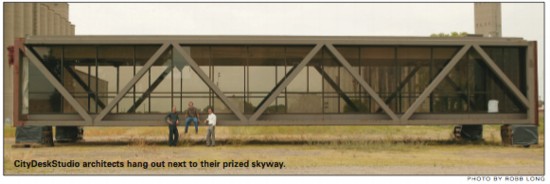
And it’s probably a little more than they paid for it in 2006, when the architects bought it on a whim at a University of Minnesota blind auction. According to a report at the time, it cost them more to move it [two blocks] than to buy it.
Right now, the skyway is sitting somewhere “near the University of Minnesota Minneapolis campus,” and you’ll need to move it. Fortunately, the U of MN is on the Mississippi River, so if you could get the skyway onto a barge, you could float it down the river and into the Gulf of Mexico. From there, you could load it onto a freighter and sail it anywhere on the East Coast. Hell, you could sail it anywhere in the world.
Then plop it down right next to the smug schmuck who just topped off his shipping container house, the one with the 8-ft ceilings and the less-than-10-ft wide rooms. Then invite him over for a hot dish.
Skyway for sale – THAT’S RIGHT – AN ACTUAL SKYWAY! – $79500 (Minneapolis) [minneapolis.craigslist.org, via walker blog, thanks andy]
A Disconnected Skyway: Downtown architectural firm considers new options for an ‘icon’ of the skyline [2006 downtown journal article, pdf]
City Desk Studio Skyway Retreat (unrealized) [citydeskstudio.com]
Before There Were Shipping Container Architectures
Awesome, just awesome. Catherina Scholten’s set design for a 2005 production of Chekhov’s “Ivanov” at the outdoor theater in the Amsterdamse Bos [Woods] is just awesome.
Shipping containers topped with mobile homes and trailers, it’s the bestlooking mashup of prefab/modular and adaptive reuse I’ve seen in a long time.
As someone who grew up in North Carolina, where our rural landscapes were always dotted with trailer homes, and where our local newscasts were always dotted with reports of these same trailer homes being destroyed by tornadoes and hurricanes, the prefab and shipping container architecture industry’s condescending silence on the subject of trailer homes has been an embarrassment.
Get in touch with your brokeass roots, hipsters! The Dutch have already leapfrogged ahead!
There are wider and more detailed photos at mijn Amsterdam [via dinosaursandrobots.com]
Dude, Under Siege, Blackwater Takes On Air Of Dwell Magazine!
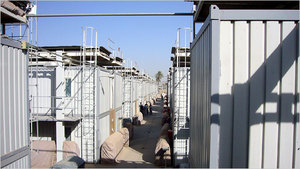
Modular, prefab, minimalist, outdoor space, nice matte finish, shipping containers… Just slap a couple of solar panels on the roof and get a book stylist in there to add a Moholy-Nagy monograph to the coffee table, I think we have our January cover!
Under Siege, Blackwater Takes On Air of Bunker [nyt]
TGI Freitag

Been a while since I’ve posted shipping container architecture news, but it’s become so hot everywhere else, I’m sure no one minds. This is worth mentioning, though.
Regine interviewed one of the Freitag brothers about the bag company’s new concept store in Zurich, which is made of a tower of shipping containers. It showed up on flickr a couple of weeks ago, too.
But this just reminds me how, every time I drive between NYC and DC, I fantasize about living in a tricked out stack of shipping containers like the ones stacked along the Turnpike. sigh.
17 containers for a concept store [wmmna, with lots of pix]
tons of photos, including official construction/fabrication images at freitag+zurich on flickr [flickr]
Shipping Containers, v. 4
It’s an inadvertent but recurring subject of interest here at greg.org: the architectural use of connex shipping containers. Sunday, NPR aired a puffy little interview with Zalmay Khalilzad, the new US envoy to Afghanistan; it turns out he’ll be living in a shipping container on the heavily fortified grounds of the embassy in Kabul. He’s not alone. According to this AP story on AfghanNews.net, over 100 containers were refurbished in Dubai to provide instant housing for the influx of US personnel. This picture comes from an account of someone posted to Kabul. Americans may have added microwaves, TV’s, private baths, A/C, “some tentative-looking shrubs and bushes” out front, and in one case, a pink flamingo to their containers, but except for their fresh coats of paint, they’d blend right in to the Kabul skyline. Except, of course, that US containers are reinforced with sandbags and ringed with concertina wire.

Don’t let a construction industry devastated by 30 years of chaos
get you down! Rebuild your marketplace with containers!
image: Barnaby Hall’s travelogue in Duke’s alumni magazine.
Turns out you can fit a lot of irony into a 40-foot shipping container. And just when you think it’s full, well, you can stuff in some more. Another Afghani-related compound, Guantanamo’s Camp Delta, is built from shipping containers. But so, it turns out, is the Army/CIA’s interrogation center at Bagram Air Base, the site of reported torture and human rights violations in the name of our war on terror. (As the WP quotes one official, “If you don’t violate someone’s human rights some of the time, you probably aren’t doing your job.”) They’re also the structure of choice for expanding Israeli outposts in the West Bank. Containers, concertina wire, and conflict apparently go hand in hand.
With their adaptability, rapid portability, and instant utility, containers are the architectural embodiment of “Flexible Response,” Donald Rumsfeld’s doctrine of military transformation. Of course, “Flexible Response” isn’t new; it grew from the Korean War, and Rumsfeld’s predecessor Robert McNamara implemented his own quant-heavy interpretation in Vietnam. The 21st-century version is just air-conditioned for our comfort.
Here’s the AP’s glowing, realtor-like description of Khalilzad’s new pad: “Three containers were used to create his relatively palatial hootch, with a formal dining room that can seat eight, a front sitting room and a side lawn. A wooden fence around the ambassadorial residence gives it privacy and a suburban hominess.”
A hootch? If you have to ask–and I had to– a hootch is soldiers’ slang for instant housing, particularly the aluminum sheds they inhabited in Vietnam.
Related: the Darren Almond shipping container post that started it all, plus some unexpectedly moving memorial realizations.
Shipping Containers, v. 3
A sporadically recurring topic here at greg.org, the non-shipping use of shipping containers. [Instigating post here, extensive post here.]

Shipping container used in an illegal Israeli outpost, image:nytimes.com
Samantha Shapiro’s NYTimes Mag story, “The Unsettlers,” profiles young, militant Israelis who pioneer illegal settlements in the West Bank.

Shipping container used in an illegal Israeli outpost in the Jordan Valley, image:metropolismag.com
Stephen Zacks’ review in the Feb. 2003 Metropolis of a (cancelled) exhibit on architecture and urban planning in the West Bank, where Israeli hilltop settlements use suburban sprawl to control the surrounding territory. Architect Eyal Weizman: “It’s almost like you have a model of the terrain and you cut a section at say six hundred meters, and everything that’s above is Israeli. What was created was an incredible fragmentation of the terrain into two systems that work across the vertical axis.” The Israeli human rights group B’Tselem has published Weizman’s exhaustively documented settlement map of the West Bank.
For all your settling needs, illegal or otherwise, the Shipping Container Store: passing the mountainous container landscape along the NJ Turnpike, I saw Interport Maintenance Corp., which sells shipping containers. Delivery is extra.
On The Transformative Power of Architecture, or The Caribbean Light At The End of The Tunnel
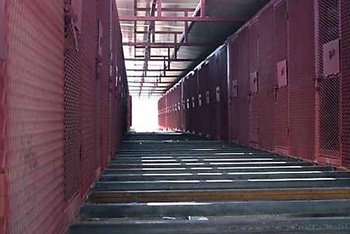
image via globalsecurity.org
Last month I wrote about art and architecture made from connex containers, the standard 40-foot steel boxes used for international shipping. #1 architects MVRDV proposed a complex made from them for Rotterdam, their home town (and a major port). As the discussion on this architecture message board shows, container architecture is an idea with a lot of adherents.
Now you can add the Department of Military Aesthetics to the list. Containers were used to construct Camp Delta, the more permanent neighbor of Camp X-Ray, on the military base under US control (if not jurisdiction) in Guantanamo, Cuba. Here’s a description from Joseph Lelyveld’s very long NY Review of Books article about the quandary of the Guantanamo detainees:
Delta was thrown together for $9.7 million by a private contractor, Brown and Root Services�a division of Vice President Cheney’s old company, Halliburton�which flew in low-wage contract labor from the Philippines and India to get the job done, in much the same way that Asians were once brought to the Caribbean to harvest sugar cane. The cell blocks are assembled from the standard forty-foot steel boxes called connex containers that are used in international shipping: five cells to a container, eight containers to a cell block, with four lined up on each side of a central corridor where the lights and fans are installed. Welders cut away three sides of each container, replacing them with sidings of steel mesh, leaving the roof, floor, and one steel wall into which a window was cut. Floor-level toilets were installed�the kind requiring squatting, traditionally described as � la turque�and now these are sometimes mentioned as an example of American sensitivity to the cultural needs of the detainees.
carry-on luggage, four weeks later
Nearly a month after an accidental click into a carry-on luggage article brought my surfing to a teary halt, it’s okay to laugh again. In this week’s New Yorker, Nick Paumgarten tells of of several successful attempts to carry Emmy Award statuettes (complete with “sharp-tipped wings”…shaped like “serrated steak knives”) onto transatlantic flights. [Apparently, none of the comedy writers or filmmakers in the story are yet listed on Ashcroft’s dissenter=terrorist no-fly list or are giants of Iranian cinema.]

